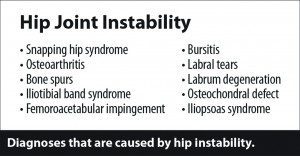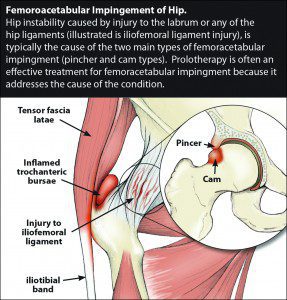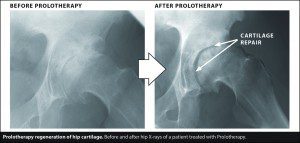By Debra K. Brinker, RN

Are you trying to get to the core of your hip pain or arthritis? Joint instability may be an overlooked reason why you have not yet found long term pain relief. Over the last decade, hip injuries due to hip instability have become increasingly recognized as a source of pain and disability. This makes sense when one considers we move our hips at least one million times per year during activities of daily living. The high rates of wear and tear, attributable to normal use of the hip alone can result in long term problems. In sports, athletes are getting bigger and stronger, with tremendous forces being placed on them, forces that are increasing every year. Understanding the link between hip joint instability and chronic pain can help lead to answers that provide long term pain relief.
Anatomy of the hip
The hip joint is a ball-and-socket joint with massive ligaments. Because of this, the hip is known to be a very stable joint, and previously considered as a joint with infrequent injuries. The bony anatomy, muscles, labrum and ligaments of the hip all contribute to the stability of the hip. The space between the femoral head (ball) and acetabulum (socket) is sealed by the hip labrum, a ring of cartilage that surrounds the acetabulum allowing the head of the femur to articulate with the pelvis. The ligaments are collagenous fibrous structures that are primarily responsible for maintaining smooth joint motion, restraining excessive joint displacement and providing stability across the joint. When these soft tissue structures of the hip are subjected to forces beyond their normal range, injury and failure occur, resulting in hip joint instability.
Hip instability
Many painful hip conditions are due to hip instability and laxity of the joint structures, including labral tears, femoroacetabular impingement, focal rotational instability, ligament tears, dislocations and osteoarthritis. (See Figure 1.) Often, people with hip instability complain of clicking and popping of the hip that accompanies pain, stiffness, muscle spasms, or feeling of weakness or unsteadiness with hip movements.
Hip instability may be classified as traumatic or atraumatic. Traumatic causes of hip instability are often clear, and are common in sports activities like soccer, ice hockey and football. Atraumatic causes of hip instability include overuse injuries, for instance repetitive external rotation with axial loading. Also bony dysplasia, generalized ligamentous laxity, and collagen disorders including Ehlers-Danlos Syn-drome and Joint Hypermobility syndrome.

One of the most common conditions caused by traumatic instability is dislocation of the hip. Hip dislocations are seen in sports like football, rugby, hurling and soccer, and they commonly occur posteriorly due to the greater strength of the anterior capsule of the joint. The individual is hit in the front of the thigh, forcing the thigh/hip complex backward, resulting in the hip dislocation and injury to the ligamentum teres and the posterior capsule. A joint dislocation significantly disrupts all the structures that support the joint, and can create hip instability. Long-term consequences of posterior hip dislocations can include sciatic nerve injury, avascular necrosis of the femoral head and significant arthritis and cartilage damage.
Laxity of the anterior hip capsule is also seen in sports, but is more frequently associated with atraumatic instability. Activities that demand supraphysiologic joint motion such as figure skating, dance and gymnastics are causative factors. The iliofemoral ligament of the anterior hip capsule may stretch out causing a focal rotational type of instability. This type of instability can cause acetabular labrum tears and associated pain.
Femoraoacitabular Impingement (FAI)
Athletes who have to use the same stances for hours at a time, game after game, can suffer atraumatic hip instability and may lead to femoroacetabular impingement (FAI). However, the most common cause of FAI is simply some type of soft tissue injury such as an iliofemoral or ischiofemoral ligament injury. (See Figure 2.) Over time, hip instability from ligament injuries as well as a hip labral tear can cause premature osteoarthritis and FAI.

Non-surgical treatment for hip pain, arthritis, and FAI
The majority of hip instability and pain, FAI, and arthritis cases can be managed non-surgically. Surgical intervention is required in cases of large acetabular fractures. Standard therapeutic approaches (pain medications, corticosteroid injections and arthroscopy) employed to address hip instability can be ineffective long term solutions because they do not repair the underlying cause of the problem: the injured ligaments and labrum.
Non-surgical treatments, including Prolotherapy and Orthobiologic treatments are regenerative options that can repair the instability by restarting the repair processes in and around the hip joint. These natural injection therapies facilitate the restoration of the degenerated ligaments, cartilage, and labrum to a healthy state, improving function and reducing pain. (See Figure 3.)
Prolotherapy Specialists:
239-303-4546
www.CaringMedical.com







